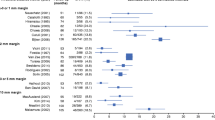Abstract
Background
The impact of close margins in patients with ductal carcinoma-in situ (DCIS) treated with mastectomy is unclear; however, this finding may lead to a recommendation for postmastectomy radiotherapy (PMRT). We sought to determine the incidence and consequences of close margins in patients with DCIS treated with mastectomy.
Methods
The records of 810 patients with DCIS treated with mastectomy from 1996 through 2009 were reviewed. Clinical and pathologic factors were analyzed with respect to final margin status. Median follow-up was 6.3 years.
Results
Overall, 94 patients (11.7 %) had close margins (positive, n = 5; negative but ≤1 mm, n = 54; 1.1–2.9 mm, n = 35). Independent risk factors for close margins included multicentricity, pathologic lesion size ≥1.5 cm, and necrosis, but not age, use of skin-sparing mastectomy, or immediate reconstruction (p > 0.05). Seven patients received PMRT, and none had a locoregional recurrence (LRR). Among the remaining 803 patients, the 10-year LRR rate was 1 % (5.0 % for margins ≤1 mm, 3.6 % for margins 1.1–2.9 mm, and 0.7 % for margins ≥3 mm [p < 0.001]). The 10-year rate of contralateral breast cancer was 6.4 %. On multivariate analysis, close margins was the only independent predictor of LRR (p = 0.005).
Conclusions
Close margins occur in a minority of patients undergoing mastectomy for DCIS and is the only independent risk factor for LRR. As the LRR rate in patients with close margins is low and less than the rate of contralateral breast cancer, PMRT is not warranted except for patients with multiple close/positive margins that cannot be surgically excised.
Similar content being viewed by others
References
Kuerer HM, Albarracin CT, Yang WT, et al. Ductal carcinoma in situ: state of the science and roadmap to advance the field. J Clin Oncol. 2009;27:279–88.
Jemal A, Siegel R, Ward E, et al. Cancer statistics, 2008. CA Cancer J Clin. 2008;58:71–96.
Burstein HJ, Polyak K, Wong JS, Lester SC, Kaelin CM. Ductal carcinoma in situ of the breast. N Engl J Med. 2004;350:1430–41.
Baxter NN, Virnig BA, Durham SB, Tuttle TM. Trends in the treatment of ductal carcinoma in situ of the breast. J Natl Cancer Inst. 2004;96:443–8.
Smith GL, Smith BD, Haffty BG. Rationalization and regionalization of treatment for ductal carcinoma in situ of the breast. Int J Radiat Oncol Biol Phys. 2006;65:1397–403.
Silverstein MJ, Barth A, Poller DN, et al. Ten-year results comparing mastectomy to excision and radiation therapy for ductal carcinoma in situ of the breast. Eur J Cancer. 1995;31A:1425–7.
Silverstein MJ, Lagios MD, Martino S, et al. Outcome after invasive local recurrence in patients with ductal carcinoma in situ of the breast. J Clin Oncol. 1998;16:1367–73.
Schouten van der Velden AP, van Vugt R, Van Dijck JA, Leer JW, Wobbes T. Local recurrences after different treatment strategies for ductal carcinoma in situ of the breast: a population-based study in the East Netherlands. Int J Radiat Oncol Biol Phys. 2007;69:703–10.
Meijnen P, Oldenburg HS, Peterse JL, Bartelink H, Rutgers EJ. Clinical outcome after selective treatment of patients diagnosed with ductal carcinoma in situ of the breast. Ann Surg Oncol. 2008;15:235–43.
Lee LA, Silverstein MJ, Chung CT, et al. Breast cancer-specific mortality after invasive local recurrence in patients with ductal carcinoma-in situ of the breast. Am J Surg. 2006;192:416–9.
Carlson GW, Page A, Johnson E, Nicholson K, Styblo TM, Wood WC. Local recurrence of ductal carcinoma in situ after skin-sparing mastectomy. J Am Coll Surg. 2007;204:1074–8.
Chan LW, Rabban J, Hwang ES, et al. Is radiation indicated in patients with ductal carcinoma in situ and close or positive mastectomy margins? Int J Radiat Oncol Biol Phys. 2011;80:25–30.
Godat LN, Horton JK, Shen P, Stewart JH, Wentworth S, Levine EA. Recurrence after mastectomy for ductal carcinoma in situ. Am Surg. 2009;75:592–5.
Kelley L, Silverstein M, Guerra L. Analyzing the risk of recurrence after mastectomy for DCIS: a new use for the USC/Van Nuys Prognostic Index. Ann Surg Oncol. 2011;18:459–62.
Childs SK, Chen YH, Duggan MM, et al. Impact of margin status on local recurrence after mastectomy for ductal carcinoma in situ. Int J Radiat Oncol Biol Phys. 2013;85:948–52.
Chadha M, Portenoy J, Boolbol SK, Gillego A, Harrison LB. Is there a role for postmastectomy radiation therapy in ductal carcinoma in situ? Int J Surg Oncol. 2012;2012:423520.
Lari SA, Kuerer HM. Biological markers in DCIS and risk of breast recurrence: a systematic review. J Cancer. 2011;2:232–61.
Rashtian A, Iganej S, Amy Liu IL, Natarajan S. Close or positive margins after mastectomy for DCIS: pattern of relapse and potential indications for radiotherapy. Int J Radiat Oncol Biol Phys. 2008;72:1016–20.
Owen D, Tyldesley S, Alexander C, et al. Outcomes in patients treated with mastectomy for ductal carcinoma in situ. Int J Radiat Oncol Biol Phys. 2012;85:129–34.
Mallon PT, McIntosh SA. Post mastectomy radiotherapy in breast cancer: a survey of current United Kingdom practice. J BUON. 2012;17:245–8.
Kim JH, Tavassoli F, Haffty BG. Chest wall relapse after mastectomy for ductal carcinoma in situ: a report of 10 cases with a review of the literature. Cancer J. 2006;12:92–101.
Acknowledgment
The University of Texas MD Anderson Cancer Center is supported in part by the National Institutes of Health through Cancer Center Support Grant CA016672. The authors thank Stephanie Deming for editorial assistance.
Disclosures
The authors declare no conflict of interest.
Author information
Authors and Affiliations
Corresponding author
Rights and permissions
About this article
Cite this article
FitzSullivan, E., Lari, S.A., Smith, B. et al. Incidence and Consequence of Close Margins in Patients with Ductal Carcinoma-In Situ Treated with Mastectomy: Is Further Therapy Warranted?. Ann Surg Oncol 20, 4103–4112 (2013). https://doi.org/10.1245/s10434-013-3194-0
Received:
Published:
Issue Date:
DOI: https://doi.org/10.1245/s10434-013-3194-0




